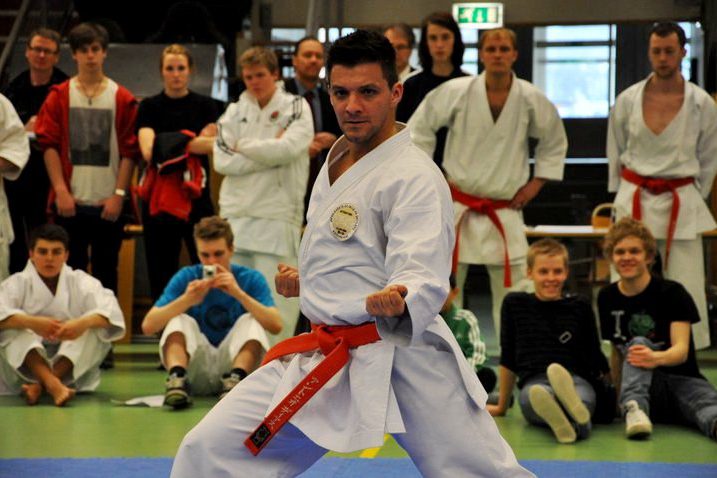I think I was 15 years old when first I sparred against this evil Russian Ju-jutsu expert.
He was smaller than me, but his neck was probably made of adamantium and his techniques were top notch. If I remember correctly, in the World Ju-jutsu Games he had broken his opponents hand with a kote-gaeshi wrist lock once, a lock which is virtually unheard of in free sparring.
I considered this fact so awesome that I still remember it.
The Russian knew his stuff, in other words.
I don’t remember much from our numerous sparring sessions though, but the result was more often than not both blood and tears on my part. The Russian, who will remain anonymous (for fear of retribution!) always despised my “jumping around” style of Karate kumite (which was all that I knew), and himself stood very stable in a low stance, waiting for me to come in so he could take advantage of my exposed areas with his evil Ju-jutsu tricks.
Once, he tried to explain a technique in his broken Russian/English, but all that came out was: “Blood… Fist. Make.” which I will never forget. To a 15-year-old, that was the coolest thing you could possibly hear – especially coming from this Russian Ju-jutsu god.
I learned very many things from The Russian.
In particular, very many things which has connection to Karate, either directly or indirectly. For instance, after being kicked hard straight in the chest, headbutted on the nose, and immediately thrown down with a uchi-mata throw (“what just happened?!”), I asked him how he could have such a good guard! I mean, the only good “opening” I could see in his small frame was his front leg, which I had tried to sweep away when he surprised me with the aforementioned combination.
So he taught me.
(That’s what he was paid for, after all)
First of all I had to quit jumping around. I had to stand in a very stable stance, perhaps best described with the Shotokan term sochin-dachi, and then tilt my pelvis while I exhaled forcefully, compressing my trunk. This very tight, shrunken, position was ideal for defense and attack he assured me, and I believed him. I mean, I had felt it after all!
So there I stood, next to him (trying to imitate his stance) when he suddenly, very seriously, said: “Like Sanchin kata”.
“Wh-wha…?” I thought. “He knows Sanchin kata? Okay…”
I didn’t ask. I just inhaled, exhaled briefly, increased my internal pressure, and “fixated” my hips – making my whole trunk tight like a vise.
“Good”, the Russian said, looking up over his tinted glasses.
He spoke with the wisdom that can only come from experience, like a guy who went blind because he looked at a solar eclipse without one of those boxes with a pinhole in it and now goes around the country speaking at high schools about the dangers of looking at a solar eclipse without one of those boxes with a pinhole in it.
And that was one of my first memories of how some important physical lessons of Karate stretch far beyond the walls of the traditional dojo.
In this case, the lesson consisted mainly of two important points often emphasised in Naha-te (the ancient “style” of Karate practise in and around the Okinawan capital of Naha). Today, Naha-te is mainly represented in the modern style of Goju-ryu, but also in Shito-ryu to great extent (although often misinterpreted and done in a Shuri-te fashion).
The lessons were two physical principles that are heavily used in higher levels of all style of Karate (I presume, though I rarely see it being neither taught nor practised!) but is most obviously emphasised in the Naha-te tradition (which uses Sanchin kata as it’s principal tool for transmitting these two principles.)
What the fudge am I talking about?
I’m talking pelvic tilting (1) and transversus abdominis (2).
Naha-te style Karate can “easily” (I realize this is a relative term) teach us all something on these two very important points, whether you’re a weightlifter, a Ju-jutsuka, an old dude with incontinence, a kickboxer or a woman giving birth. Because all of the above categories need to use (and preferably master) 1. pelvic tilting and 2. transversus abdominis or face the consequences. Which obviously ranges from failing to lift a heavy weight to wetting yourself.
None of which is any pleasant.
And though I realize that these two principles are not really that “secret” (as I write in the headline) they are for some reason never stressed enough in Karate today, which to me makes them seem secret.
But they aren’t, really.
I mean, either most people don’t know (?), think it’s too advanced (?!) or they know but are not confident/knowledgeable enough to actually speak or teach about this to a significant degree.
I don’t know.
But I’m about to change that with this post.
Not that I am an expert or anything myself… but hey, who said you need to be an expert to teach “secret” stuff?
(Okay, that was low.)
Let’s begin with number 1.
Naha-te Lesson #1: Pelvic Tilting.
First of all, you need to know that changes in our posture produce significant changes in muscle action.
This is a well-known fact in strength training, where coaches often advice their athletes to either look up at the ceiling, curve the back, flex this or that joint, look straight ahead, pull the shoulders back, have a straight back etc. to get a specific, desired, outcome.
This is considered basics (“kihon”) in strength training, but for some reason, in the midst of all our punching, blocking and kicking we Karate people often tend to neglect it.
In certain cases, even minor changes in the position of the body’s links (joints) can lead to significant changes in power output. For example, pronation of the forearm decreases the strength of the arm in flexion by one third (Rasch, 1956; Wells, 1960; Tricker, 1967)!
Another example is… slight flexion of the elbows during a barbell clean from the ground decreases the lifting force by 40%, a flexed trunk by 13,3% and a lateral tilting head by an average of 9% (Sokolov, 1967)! So, basically, you can mess everything up by not having a good (correct) posture.
There are numerous other examples, but I don’t want to bore you any more.
In other words, to produce maximal force in a movement (punch, kick, lock, throw, blow…) we must always consider anatomical stability and ensure that at crucial moments posture enables the muscles to develop maximal force.
And yes, as you might have figured out, the pelvis plays a vital role in this.
Why?
A quick look over at wikipedia gives us a good answer:
The pelvis is the section between the legs and the torso that connects the spine (backbone) to the thigh bones.
The pelvis is the major link between the spinal column and and the lower extremities (which start the “power wave”). Therefore, incorrect movement and/or positioning of the pelvis can lead to considerably decreased anatomical stability and weak posture. And not only will incorrect orientation of the pelvis give us weak and useless techniques, but it might even injure us (spinal flexion combined with rotation is a perfect recipe for slipped (herniated) discs.).
So, proper knowledge of the hip area (“koshi“) is a serious issue in Karate.
Enter the pelvic tilt.
Perhaps you’ve heard it before (“fixate your hip”). In fact, many personal fitness instructors insist that their clients use pelvic tilt to move safely and correctly because they believe there is only one pelvic tilt for human movement. But, the thruth is that there is basically two (actually many more since the pelvis is a 3-D object, but only two practical ones for now, okay?).
I’m talking:
- Anterior pelvic tilt
- Posterior pelvic tilt
One tips the hips back, and one forth. One is used for squatting, lifting heavy loads off the floor and toe touching, while the other is used for situps, lifting objects above waist level… and general Karate moves.
Posterior pelvic tilt is the one we want, for now.
Remember the name and you’ll sound really smart. Kind of like me.
Posterior pelvic tilting, which is über important in Karate, is sometimes described as “tucking the tail between the legs”. The purpose of this pelvic tilt is to maintain the neutral lumbar curvature as closely as possible, while excerting Karate power moves (punches, kicks…).
Correct posterior pelvic tilting ensures that our upper and lower body halves are perfectly connected for ensuring maximum sophisticated Karate power.
And Naha-te people (Goju-ryu people, really) are supposed to be masters of this fact, even though it should be in all styles and fractions of Karate (if we are to get somewhere with this thing).
So how do we train this posterior pelvic tilt?
Here’s a good excercise (requiring a medicine ball) in a video that I just discovered the other day, performed by World Champion (and doctor!) Lucio Maurino.
Look at 1:28:
Sexeyhh…
Another good exercise is lying on the floor (on your back) with your knees tucked to your chest, as illustrated by the yoga picture below:

Then, slowly straighten your legs and bring them down to the floor, until you are lying completely straight.
The connection you had (with your back and pelvis against the floor) in the initial, tucked, position should be maintained at all times. If you lose it, try again.
Some people actually have a hard time keeping it when the legs are straightened.
Did you succeed?
Then stand up and try to keep the same pelvic tilt while doing other, slow, stuff (Sanchin kata for example). If you didn’t succeed, and think this whole post is nothing but bull crap, then please work on the four key muscles involved in the posterior pelvic tilt (gluteals, hamstrings, hip flexors and lumbar spine extensors), because there clearly is something wrong with you.
🙂
Anyhow, when you can easily shift between anterior and posterior pelvic tilt, and when you can do it fast, along with different techniques (both fast and slow), combining them with correct breathing, and using them in correct situations (if you’re lifting somebody to throw you would NOT want to have posterior pelvic tilt!) you can titulate yourself (P)elvis, the King of Rock Karate.
Nice.
And that concludes lesson #1 in “Naha-te’s 2 Greatest Secret Lessons”, which are about to be very un-secret.



7 Comments